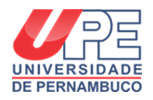
Student: IGINO GIORDANI DA SILVA GUERRA
Title: POTENCIAL DE APRIMORAMENTO DA PASTEURIZAÇÃO LENTA DO LEITE DEVIDO À UTILIZAÇÃO DA ENERGIA SOLAR TÉRMICA E DO RESFRIAMENTO EVAPORATIVO
Supervisor: PROF. DR. LUIS ARTURO GÓMEZ MALAGÓN
External Examiner: PROF. DR. ALCIDES CODECEIRA NETO
Internal Examiner: PROF. DR. JORNANDES DIAS DA SILVA
Date: JUNE 13th, 2023
Time: 10:00
Place: Online
Abstract:
The State of Pernambuco contains four Local Productive Arrangements (APL), including one that encompasses 15 cities, with a hub in Garanhuns and in which milk production and dairy processing are the main economic activities. Cheese is a product derived from milk, and its initial manufacturing processes are filtration, pasteurization (heating, retention and cooling), fermentation and coagulation. To guarantee the hygienic-sanitary conditions in the brazilian enterprises, the industrialization of milk for the production of its derivatives is regulated by the Ministério da Agricultura, Pecuária e Abastecimento. Specifically for small cheese producers, the legislation allows the milk to be “slowly pasteurized” in a double-jacket tank. This tank is a reservoir with metallic surfaces that separate the milk from the working fluid and slow pasteurization is an activity that requires thermal energy to heat the milk up to 63 °C. Heat transfer to it is carried out indirectly by heating water, this temperature must be maintained for 30 minutes and then it must be cooled to 37°C so that the yeast is added and the clot formed in the tank. Typically, the small producers in the Pernambuco APL use heating systems consisting of Liquefied Petroleum Gas stoves installed below the double- jacket tank and the cooling operation is conducted by filling the tank with water at room temperature, promoting its flow in a single-pass configuration and no reuse. To improve the cheese making process, this work proposes the use of a solar thermal system to supply preheated water and a low cost cooling tower. Prototypes were tested and the complete slow pasteurization process was monitored a few times, using electronic instrumentation to measure and record process time, fluid temperatures, water flow and air humidity. From these measurements, the heat transfer rates developed and the net amounts of heat transferred were calculated to evaluate the energy performance of the operations. The results showed that the use of preheated water and the cooling tower integrated with the double-jacket tank reflects in time, fuel and water savings, giving the enterprise an increase in productivity and mitigation of operational costs and negative environmental impacts.
Keywords: Milk Processing; Slow Pasteurization; Cheese Production; Thermal Solar Energy; Cooling Tower; Energetic Performance.


